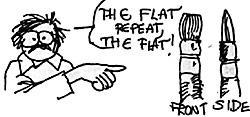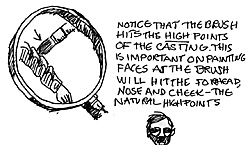Since I do most of my professional work in art it is always very easy to lapse into terms that most people don't use- a kind of high tech talk. Do you want to see those brushes spindle and mutilate, paint clog and gross stuff that you would never believe? I won't tell; but maybe I'll give a few hints.
Our fearless editor asked me about drybrushing. Now drybrushing is an old painting trick and deserves a more thorough explanation.
The purpose of dry brushing is to put a lighter color over a darker one, and to make it look natural-kind of like putting a spotlight on a figure without the fake shadows so beloved by the 54mm painters with their theatrical style of painting.
 Okay, let's take this from the top: we want to use the
type of brushes that we art types like to call flats (ill. 1).
Depending on how detailed the figure is either a number
one or two brush should prove sufficient for either 15mm or
25mm scale. Which one you use, I trust to your judgment.
Okay, let's take this from the top: we want to use the
type of brushes that we art types like to call flats (ill. 1).
Depending on how detailed the figure is either a number
one or two brush should prove sufficient for either 15mm or
25mm scale. Which one you use, I trust to your judgment.
Now when we use drybrushing to produce shading we are carrying out the following process; after a figure is painted with the basic color a bit of white is added to the color and then a dry brush with a partially dry color is used.
 This drying paint is brushed on to the figure as per
the illustration (2). Think of the sun as always being at
noon and with this image of your light source you brush
directly down from directly over your figure. Keep your
brush dry and you will get the desired effect-dry brushing
will hit only the high relief parts of the figure and will give
you the most natural effect that is obtainable.
This drying paint is brushed on to the figure as per
the illustration (2). Think of the sun as always being at
noon and with this image of your light source you brush
directly down from directly over your figure. Keep your
brush dry and you will get the desired effect-dry brushing
will hit only the high relief parts of the figure and will give
you the most natural effect that is obtainable.
I get worried when people start talking about creating shading effects on their figures, dry brushing will do it but if you insist on doing shading, a quick method is to use a mix of black or brown with water and "wash" it into all crevices and folds of uniforms and cloaks. But watch it. It's too easy for you to turn a figure into a Halloween character. A discussion of other methods of shading will have to wait for another time as it would consume too much space to be included here.
Terrain Bases
Now, speaking of Terrain: let me tell you what I do with my base-desires. I paint my figure bases with a white glue and then dip the figures in a mix of green-brown railroad sawdust which gives the figures a realistic appearance. The next article will be on terrain and the grounded sciences.
So this gives you my own particular base desires and all I can tell you is to just brush off!!!
Back to Table of Contents -- Courier Vol. V #3
To Courier List of Issues
To MagWeb Master Magazine List
© Copyright 1984 by The Courier Publishing Company.
This article appears in MagWeb (Magazine Web) on the Internet World Wide Web.
Other military history articles and gaming articles are available at http://www.magweb.com